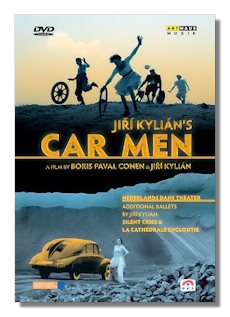
The Internet's Premier Classical Music Source
Related Links
- Latest Reviews
- More Reviews
-
By Composer
-
Collections
DVD & Blu-ray
Books
Concert Reviews
Articles/Interviews
Software
Audio
Search Amazon
Recommended Links
Site News
 DVD Review
DVD Review
Jiří Kylián

Ballets
- Car Men
- Silent Cries
- La Cathédrale engloutie
Netherlands Dance Theater
Arthaus Musik 102101 DVD 61:00
Choreographer Jiří Kylián has shown his interest in physical comedy before: Birth-day (set to the music of Mozart) contains a side-splitting Rococo bed scene for an enthusiastic woman and her somewhat overwhelmed partner, and there's a scene for a cook and his assistant that is worthy of Charlie Chaplin. Car Men, a new film created with director Boris Pavel Conen, takes the idea one step further, and footage from vintage silent films even has been inserted into the action.
Bizet's Carmen has been re-imagined in many ways. Kylián and Conen, not to be outdone, have set Car Men in a wasteland around an abandoned coal mine. Carmen, Don José, Micaëla, and Escamillo are happy-go-lucky bums who cavort to composer Han Otten's fantastic arrangement of motives from Bizet's score. (Imagine Carmen re-composed by The Chipmunks and Spike Jones and his City Slickers.) The four of them get their fun from wheels, but when an actual automobile briefly appears, everything changes. The automobile, which apparently represents Fate, inspires and haunts Carmen. Soon, the four of them are building their own car out of scrap metal, and the old jealousies arise. Carmen eventually leaves Don José for Escamillo. In 26 minutes, Kylián and Conen give us love, hate, death, and slapstick auto races, and they do it in a way that makes us either laugh helplessly or shake our heads over the surrealism of it all. The four dancers come from Netherlands Dance Theatre III, which Kylián created in the 1990s to provide opportunities for dancers 40 and older. The role of Carmen is played by Sabine Kupferberg, who was married to Kylián at one point. She has tremendous magnetism – as a Carmen should – and the other three dancers are just as good. Car Men isn't a dance piece in the usual sense. One might better refer to it as a piece about movement and facial expression that doesn't fit into any particular category. It's fun and thought-provoking – definitely worth the time!
We see a much younger Kupferberg in Silent Cries, a 12-minute solo set to Debussy's Prelude to the Afternoon of a Faun. Most of piece is danced behind a dirt-smeared panel of glass, which separates the dancer from the viewer, and which she must confront just as she must confront her own anxieties. This is an intense piece, and again, it depends not just on body movements but also on facial expression. Kupferberg is wonderful, and her erstwhile husband's ideas are challenging and powerful.
The last piece is La Cathédrale engloutie, a quartet for two men and two women. Debussy's eponymous piano work appears in tiny fragments throughout, and is played fully only near the end. Most of the time, however, the dancers are accompanied by and respond to the sounds of waves breaking violently on the shore. This is the most traditional of the three works on this DVD, although Kylián's choreography doesn't look like anyone else's. The overarching mood here is one of agitation. Kylián was not trying to retell the story of the sunken cathedral and its watery bells, but of the tension between law (divine, human, and maybe physical) and free will. The four young dancers of NDT leave one stunned with their flexibility, strength, and concentration.
The DVD captures these works cleanly, and Car Men looks particularly good because it was created with cameras in mind. This is another desirable addition to the Kylián videography.
Copyright © 2009, Raymond Tuttle




















